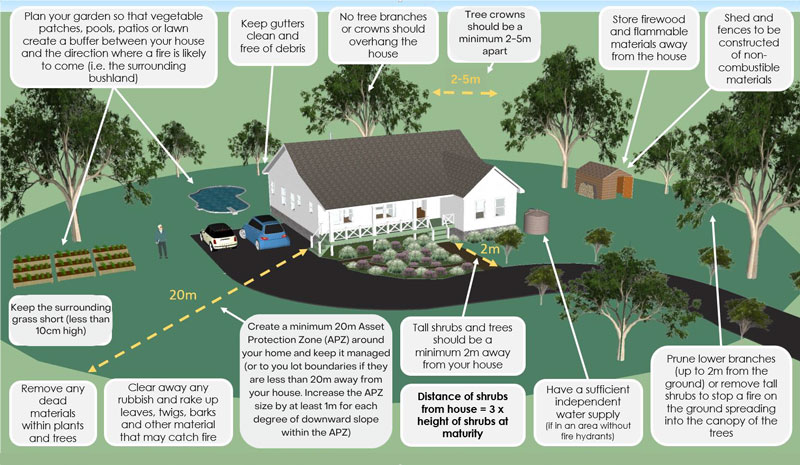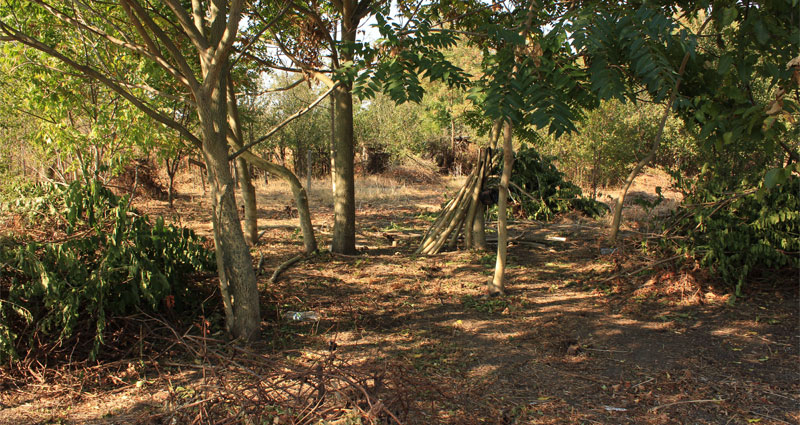Prepare your gardens
Designing and managing trees and vegetation around your home can make all the difference in a bush fire situation. In the recent 2019-2020 Victorian and NSW bush fires, many homes were lost as a result of poor maintenance to the garden areas. Follow the tips below and you can improve the chances of your home surviving intact
Keeping the area around your home clear of flammable debris and vegetation can slow the spread of a bush fire and will provide firefighters with a safe area to defend your property.
- Maintain your garden and keep the grass cut short (less than 10 centimetres) during bush fire season.
- Clear out overgrown vegetation, overhanging branches within 10 metres of the house and leaves from around your home, and especially your roof valleys and gutters.
- Remove flammable material from around your property, e.g. door mats, piles of wood, mulch and compost, grass clippings, leaves, blankets in dog kennels, outdoor furniture, gardening equipment, etc.

Image adopted from Shire of Serpentine Jarrahdale (2023). Click on image for larger version.
Keeping things neat and tidy is important, but if you live in a bush fire prone area, it’s best to have your garden planned in such a way that leaves your actual house secure by creating a ‘defendable space’ or an Asset Protection Zone (APZ) (of up to 20m) around it.
- Keep trees and garden beds a safe distance from the house (min 2-3m), particularly if you want them to grow very thickly.
- When landscaping, choose plants with low flammability and locate them away from house and other structures to help reduce bush fire risk within a garden. For example, where carefully chosen, rows of trees can provide a wind break to trap embers and flying debris that otherwise could reach a house or asset.
- Consider using pebbles and tiles closer to your home, instead of flammable vegetation and mulch.
- Consider keeping a dug area around the perimeter of your house or erecting non-combustible walls (made of brick, earth, stone, concrete or galvanised iron) between the house and the garden to act as another barrier against the fire.
Ensure that the fencing and other structures around your home are non-combustible.
- A 50m clearing
- Bare soil
- Species habitat destruction
- An excuse to remove all vegetation without regard to the effects on the environment or reserve
- Ensure garden hoses are long enough to reach the perimeter boundary of your property.
- If you have a pool, spa, tank or dam, firefighters can use it in their efforts to put out a fire, and ultimately save your home. Make sure to display a Static Water Supply (SWS) sign at the entrance to your property, so firefighters know where they can access water.
- If there's a fire hydrant outside your home, ensure it is easily located and not obstructed.
- When you decide to leave the property, unlock gates and remove covers to make sure your water source is easily accessible.
- If you decide to stay and defend your home, it’s important to understand that water mains may not provide a reliable water supply during bush fires. You may need to consider organising an independent water supply, such as water tanks, and a means to pump the water in the event of power loss, such as a generator.
Well before the peak bush fire season, it’s important to undertake home repairs and installations to make your home more resilient. We have provided a few low-, medium- and high-cost ideas for your consideration in the next section.
RFS equivalent in Victoria – Country Fire Authority (CFA) – have developed a range of useful materials to help you navigate landscaping for bush fire, including:
- Great videos on Garden Design and Property Preparation for bush fires
- Landscaping for Bush fire: Garden Design and Plant Selection guide that provides information on garden design and plant selection which can be used for new or existing gardens in high-risk bush fire areas across the country
- Online Plant Selection Key to help choose plants for a garden in a high bush fire risk area
- Examples of garden designs for suburban and rural properties, as well as properties located in the coastal areas and on the hills.
Other resources
- RFS Planning for Bush Fire Protection that is designed to provide the community with advice regarding what the NSW RFS recommends as best practice for developing in bush fire prone areas, including development of APZs around your home
- CSIRO Best Practice Guide for Landscaping
- RFS Standards for asset protection zone/ defendable space around your house
- Native habitat planting in residential asset protection zones (APZ) in bush fire prone areas of urban Sydney


















